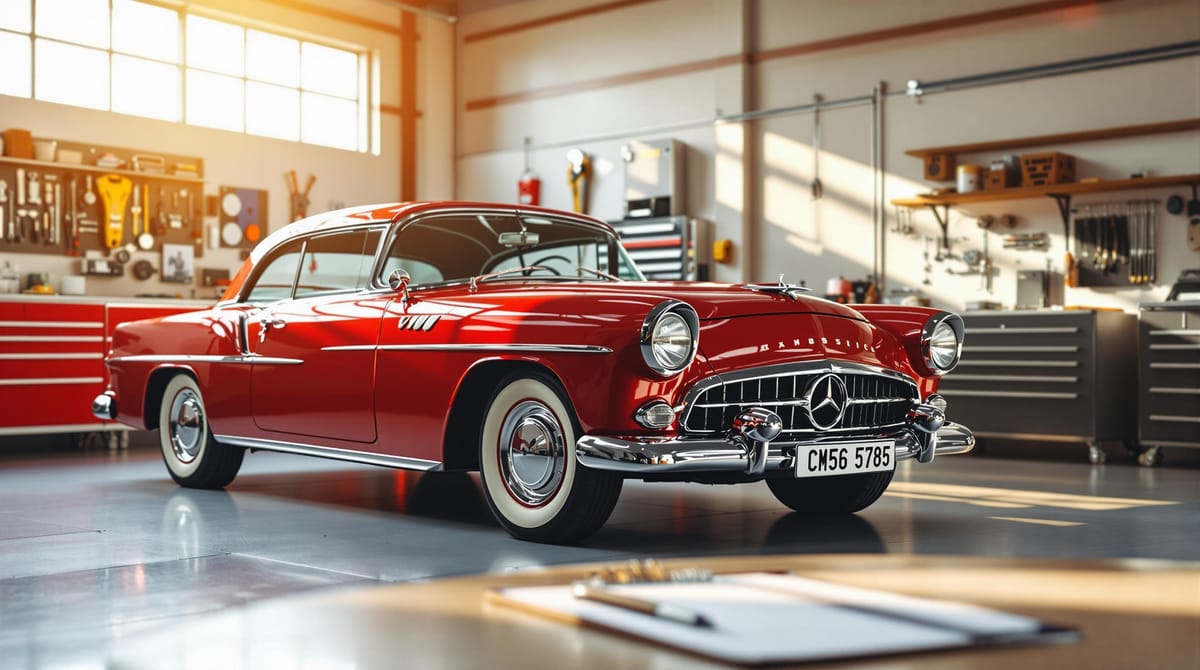5 Pre-Purchase Checks for Investment-Grade Classics
Ensure a smart investment in classic cars with five crucial checks, from vehicle history to cost planning.

Buying a classic car? Avoid costly mistakes by following these 5 essential checks:
- Check Vehicle History: Verify VINs, numbers, and original parts to confirm authenticity. Services like HPI checks can reveal hidden histories like theft or finance issues.
- Inspect the Car: Look for rust, engine issues, and review service records. Original condition often holds more value than poorly done restorations.
- Review Documentation: Ensure paperwork like V5C, MOT certificates, and service records are complete and accurate. Missing records can reduce value by up to 23%.
- Research the Market: Use tools like Classic Valuer or HAGI indices to understand trends, prices, and potential investment growth.
- Plan for Costs: Budget for repairs, insurance, and running costs. Full restorations can exceed £50,000, so weigh expenses against potential returns.
Key takeaway: A thorough inspection, proper documentation, and market research are critical to making a smart investment in a classic car. Start with the best car you can afford and plan ahead for costs.
1. Checking Vehicle History and Numbers
Verifying Numbers and Records
Start by thoroughly checking the vehicle's numbers and records. Since the 1960s, manufacturers have used serial number stamping, with the 17-character VIN system becoming the standard in 1981.
Mark Bach from eBay Motors explains:
"The classic-car world is filled with lingo. One of the most widely used specialized terms is 'matching numbers,' a way to indicate that a car still carries all its original equipment and is therefore authentic (and often more valuable)".
Statistics show that 1 in 3 cars has a hidden history, 1 in 6 has outstanding finance, and 79,390 thefts were reported in 2020. Verifying these numbers is a critical first step before assessing the car's physical condition and paperwork.
Original Parts and Build Records
When checking for original parts and build authenticity, focus on:
- Component Date Codes: Ensure dates align with the car's assembly timeline.
- Factory Documentation: Cross-reference part numbers with official records.
- Casting Numbers: Look for manufacturer markings to confirm originality.
In the UK, professional vehicle history checks are available from services like HPI and AutoCheck (Experian), starting at £5.99.
Technical Inspection Methods
To verify key components, use these inspection methods:
| Inspection Area | Verification Method | What to Look For |
|---|---|---|
| Engine Block | Physical Inspection | Matching serial numbers, original stampings |
| Transmission | Documentation Check | Factory codes, date stamps |
| Components | Technical Analysis | Casting numbers, model codes |
For example, the VIN of a 1969 Plymouth Road Runner (RM23M9A285655) can reveal details about its origin, engine type, and specifications.
"This service saved me from spending a lot of money on a vehicle that turned out to be Cat D (write-off), which wasn't mentioned to me. Would definitely recommend this company before purchasing a vehicle".
Be cautious of re-stamped engine blocks, as these can falsely inflate a car's value. Services like ICAARS offer professional authentication for high-value vehicles. These steps ensure the car meets high standards, paving the way for further physical inspections.
CLASSIC CAR PRE BUYING INSPECTION 👌 | DO THIS ...
2. Physical Inspection Guide
After verifying the vehicle's history, the next step is a thorough physical inspection to ensure everything checks out.
Body, Engine and Interior Checks
Start by examining the body for rust-prone areas. Pay close attention to key structural parts like the front wings, A-posts, sills, and floorpans.
Signs of corrosion to look for include:
- Bubbling on the surface
- Rust around windscreen frames
- Corrosion at boot corners and door edges
- Issues with double-skinned rear arches
For the engine, raise the vehicle on a ramp and inspect the following:
| Component | What to Check | Warning Signs |
|---|---|---|
| Engine Bay | Oil residue | Dark or discoloured patches |
| Suspension | Mount integrity | Rust at attachment points |
| Cross Members | Structural condition | Impact damage or corrosion |
| Fluid Systems | Leaks | Wet patches under lines |
Service History Review
Go through the maintenance records carefully. Look for consistent servicing and a reliable UK MOT history. Key items to check include:
- Specialist service stamps
- Records of parts replacements
- Historical MOT certificates
- Workshop repair invoices
Restored vs Original Condition
Classic cars often hold more value if they remain in their original condition with proper documentation. For restored vehicles, ensure:
- The restoration quality matches factory specifications
- Authenticity of replacement parts
- Detailed documentation of the restoration work
The physical condition should match the vehicle's documented history to confirm its investment potential. Keep in mind that mud trapped in hidden areas can accelerate rust. Regular cleaning and protective treatments, especially during winter, are crucial for preserving the car's value.
3. Documentation Requirements
Proper documentation backs up the findings from your physical and technical inspections, confirming whether the car is a worthwhile investment.
Past Owners and Usage History
Keep a clear record of past owners, usage, and maintenance. A complete ownership timeline, supported by continuous records, adds credibility and boosts the car's value. Always double-check that the paperwork aligns with this history.
Required Paperwork
When dealing with UK vehicles, certain documents are essential:
| Document Type | Purpose | Key Details to Verify |
|---|---|---|
| V5C Registration | Proof of ownership | Check for DVL watermark and valid serial number |
| MOT Certificates | Testing history | Look for consistent mileage progression |
| Service Records | Maintenance proof | Ensure dealer or specialist stamps are present |
Be sure to inspect the V5C document carefully. Avoid serial numbers in the ranges: BG8229501 to BG9999030 or BI2305501 to BI2800000, as these may be compromised.
Documentation and Market Value
Good documentation isn't just about verification - it can significantly affect the car's market value. Missing service records can reduce a vehicle's worth by up to 23%. On the other hand, vehicles over two years old with complete documentation often fetch 15-40% higher prices.
"According to the Courts in London, a continuous history is a full, unbroken and authentic set of documents which identify in a reliable manner who has owned the car, the uses that it has been put to and a description of its service history and any restoration, rebuilding or reconstruction work that the car has experienced throughout its life since originally leaving the factory."
Nowadays, service histories are often stored digitally, which can create challenges. Simon Rayner, a car dealer based in Worcestershire, highlights this issue:
"In many cases nowadays a car's service history is recorded on a dealer network's computer rather than in paper form, and accessing that information can be difficult later on."
For classic cars, independent garage servicing is just as valid as main dealer records, as long as the maintenance follows the manufacturer's recommended schedules. This is especially important for vehicles no longer supported by their original dealer networks.
4. Market Research Methods
Once the documents are verified, the next move is to understand the market's dynamics to make informed investment decisions. Modern analytics provide detailed insights into this niche market.
Price Research Tools
The Classic Valuer compiles data from over 40 auction houses globally. With a database covering more than 500,000 vehicles and over £20 billion in completed sales, it delivers daily-updated valuations that mirror current market trends. Its image recognition feature helps identify vehicles and estimate their worth, while the database allows precise comparisons across different marques and models.
Value Growth Indicators
Valuation tools are just the start. For a deeper dive, the HAGI™ indices offer insights based on over 100,000 verified transactions, enabling analysis of market performance across various segments. Here's a breakdown of 2024 data showing vehicle value tiers:
| Value Tier | Market Share | Total Listings (2024) |
|---|---|---|
| £32K–£80K | 24% | 30% |
| £80K–£200K | 10% | 9% |
| £200K–£400K | 3% | 2% |
| £400K–£800K | 1% | 0.5% |
These numbers highlight how higher price points are becoming more exclusive, often aligning with greater investment opportunities.
Price Trend Data
Examining price trends provides additional context. As of March 2025, the BMW Classic Index rose by 7.96% monthly (14.63% year-to-date), while the HAGI P Index for Porsche increased by 3.84% monthly (7.30% year-to-date). Broader market data shows the HAGI Top Index gained 1.07% monthly (433.50 points), Ferrari's HAGI F grew by 1.69% monthly (451.29 points), and the Mercedes-Benz HAGI MBCI increased by 1.57% (234.92 points).
5. Cost Planning
Repair Cost Assessment
Knowing the cost of repairs is essential. In the UK, shop rates now average around £135 per hour, a sharp increase from £19 per hour in 1975. Professional restorations can take anywhere from 4,000 to 5,000 hours. A detailed pre-purchase inspection is a smart way to uncover potential repair needs and set realistic expectations for ongoing costs.
Running Costs and Insurance
Here are the baseline costs for 2024/25:
| Expense Category | Annual Cost |
|---|---|
| Insurance | £561 |
| Fuel | £1,400 |
| Maintenance | £300+ |
| Road Tax | £140 |
| Storage/Garaging | £259 |
| Parking/Usage | £44 |
For investment-grade vehicles, expect higher expenses for specialised storage and comprehensive insurance coverage.
Light vs Full Restoration Costs
The scope of restoration work significantly impacts the overall cost. A light restoration, which focuses on essential mechanical fixes, typically starts at £2,000 to £5,000. Full restorations, however, demand a much larger budget.
"When I started restoring cars in 1975, I was paid £5 an hour and our shop rate was £19 per hour... Our current shop rate is £135 an hour" – Alex Finigan, Paul Russell and Company
Here’s a breakdown of typical full restoration costs:
| Component | Cost Range |
|---|---|
| Initial Vehicle | £4,000 – £16,000 |
| Parts | £6,500 – £12,000 |
| Labour | £24,500 – £52,000 |
| Paint (Showroom Quality) | £17,000 |
| Total Investment | £52,000 – £97,000 |
It’s rare to fully recoup restoration costs for models that aren’t highly sought-after. Many collectors now prefer to preserve the originality of their vehicles through careful maintenance rather than opting for full-scale restorations.
Conclusion
Checking the car's history, inspecting it thoroughly, reviewing all documents, understanding market trends, and planning for costs are key steps to making a smart investment. These five checks help buyers steer clear of expensive mistakes and make the most of their purchase.
"The cost of repairs, the lost time, the misery and the profound disappointment are something you want to avoid. The fact is a good price never trumps a bad car." - Quality Classics
A detailed history check and proper inspection are your first lines of defence against hidden problems. Repair and restoration costs can quickly add up, so these steps are essential to protect your investment. Remember, the expense doesn't stop at the purchase price - think about storage, insurance, and potential repairs. Planning ahead financially is just as important.
Working with experts and setting clear expectations during the buying process will give you an edge in the classic car market. Stick to these five steps, and you'll be well on your way to owning a classic car that brings you joy for years.




